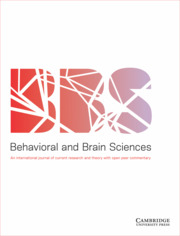Crossref Citations
This article has been cited by the following publications. This list is generated based on data provided by Crossref.
Dessus, Philippe
Tanguy, Franck
and
Tricot, André
2015.
Understanding Science Teachers’ Professional Knowledge Growth.
p.
187.
Bjorklund, David F.
and
Beers, Courtney
2016.
Evolutionary Perspectives on Child Development and Education.
p.
3.
Lancy, David F.
2016.
Evolutionary Perspectives on Child Development and Education.
p.
33.
Sharkey, Amanda J. C.
2016.
Should we welcome robot teachers?.
Ethics and Information Technology,
Vol. 18,
Issue. 4,
p.
283.
Whiten, Andrew
2017.
Social Learning and Culture in Child and Chimpanzee.
Annual Review of Psychology,
Vol. 68,
Issue. 1,
p.
129.
Lew-Levy, Sheina
Reckin, Rachel
Lavi, Noa
Cristóbal-Azkarate, Jurgi
and
Ellis-Davies, Kate
2017.
How Do Hunter-Gatherer Children Learn Subsistence Skills?.
Human Nature,
Vol. 28,
Issue. 4,
p.
367.
Kline, Michelle A.
Waring, Timothy M.
and
Salerno, Jonathan
2018.
Designing cultural multilevel selection research for sustainability science.
Sustainability Science,
Vol. 13,
Issue. 1,
p.
9.
Corriveau, Kathleen H.
Ronfard, Samuel
and
Cui, Yixin Kelly
2018.
Cognitive Mechanisms Associated with Children’s Selective Teaching.
Review of Philosophy and Psychology,
Vol. 9,
Issue. 4,
p.
831.
Ronfard, Samuel
and
Harris, Paul L.
2018.
Children’s Decision to Transmit Information is Guided by their Evaluation of the Nature of that Information.
Review of Philosophy and Psychology,
Vol. 9,
Issue. 4,
p.
849.
Fogarty, Laurel
2018.
Encyclopedia of Animal Cognition and Behavior.
p.
1.
Busch, Justin T. A.
Willard, Aiyana K.
and
Legare, Cristine H.
2018.
Active Learning from Infancy to Childhood.
p.
113.
Caldwell, Christine A.
Renner, Elizabeth
and
Atkinson, Mark
2018.
Human Teaching and Cumulative Cultural Evolution.
Review of Philosophy and Psychology,
Vol. 9,
Issue. 4,
p.
751.
Rivera, Moises
Louder, Matthew I. M.
Kleindorfer, Sonia
Liu, Wan-chun
and
Hauber, Mark E.
2018.
Avian prenatal auditory stimulation: progress and perspectives.
Behavioral Ecology and Sociobiology,
Vol. 72,
Issue. 7,
Walsh, Matthew J.
Riede, Felix
and
O’Neill, Sean
2019.
Handbook of Evolutionary Research in Archaeology.
p.
49.
Okazaki, Shuntaro
Muraoka, Yoshihiro
and
Osu, Rieko
2019.
Teacher-learner interaction quantifies scaffolding behaviour in imitation learning.
Scientific Reports,
Vol. 9,
Issue. 1,



Target article
How to learn about teaching: An evolutionary framework for the study of teaching behavior in humans and other animals
Related commentaries (38)
Another way to learn about teaching: What dogs can tell us about the evolution of pedagogy
Childhood and the evolution of higher-effort teaching
Clarifying the range of social-cognitive processes subserving human teaching
Cognitive mechanisms matter – but they do not explain the absence of teaching in chimpanzees1
Cognitive universals and cultural variation in teaching
Cooperation in human teaching
Cultural variant interaction in teaching and transmission
Does all teaching rest on evolved traits?
Evolutionary mechanisms of teaching
Eyes on the price: Human culture and its teaching
Human teaching and learning involve cultural communities, not just individuals
Is tolerance really teaching?
Learning about teaching requires thinking about the learner
Learning in and about opaque worlds
Measuring teaching through hormones and time series analysis: Towards a comparative framework1
Mind, brain, and teaching: Some directions for future research
More examples of chimpanzees teaching
Multiple dilemmas of help and counteraction to teaching in complex social worlds
On the persistent gray area between teaching and punishment
Play to learn, teach by play
Robot teachers: The very idea!
Subjectivity may hinder the application of Kline's teaching framework in comparative contexts
Systematic data are the best way forward in studies of teaching
Teacher and learner: Supervised and unsupervised learning in communities
Teaching as an exaptation
Teaching interactions are based on motor behavior embodiment
The active role played by human learners is key to understanding the efficacy of teaching in humans
The benefits of an evolutionary framework for the investigation of teaching behaviour: Emphasis should be taken off humans as a benchmark
The lowest common denominator between species for teaching behaviors
The mutual relevance of teaching and cultural attraction
The parental brain: A neural framework for study of teaching in humans and other animals
The proximate-ultimate confusion in teaching and cooperation
The study of teaching needs an inclusive functional definition
To what adaptive problems is human teaching a solution?
Understanding teaching needs development
Variations in teaching bring variations in learning
What is teaching? A clear, integrative, operational definition for teaching is still needed
“Teaching is so WEIRD”
Author response
Much to learn about teaching: Reconciling form, function, phylogeny, and development